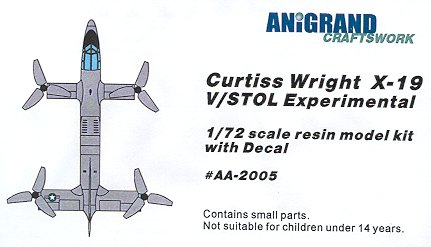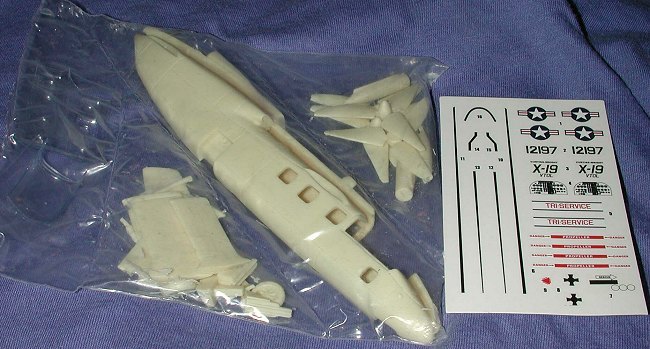
|
KIT: |
Anigrand 1/72 Curtiss-Wright X-19 |
|
KIT # |
AA-2005 |
|
PRICE: |
$39.00 MSRP |
|
DECALS: |
One option |
|
REVIEWER: |
Scott Van Aken |
|
NOTES: |
Resin kit |

|
HISTORY |
Using the radial force lift concept proven by the X-100, Curtiss-Wright designed a six-passenger civil executive transport, originally designated the X-200. As part of the Army/Navy/Air Force Tri-Service Assault Transport Program, the Air Force contracted for conversion of two prototypes, designated X-19, extensively modified for military requirements with ejection seats, rescue hoist, mock refueling probe and a fuselage stretch for improved passenger access. The 44 ft long aircraft was powered by two Lycoming T55-L-7 turboshaft engines producing 2,650 shp each. At the end of each tandem wing was a 13 ft three-bladed wide chord, high twist propeller. In order to eliminate gyroscopic and torque effects, propellers located diagonally rotated in the same direction. Roll, pitch and yaw were all controlled by differential propeller pitch. Empty weight as flown reached 10,000 lb, and gross weight over 12,000 lb. The first aircraft hovered on 20 November 1963, but suffered a hard landing. It was repaired, but problems with the control system and a series of mechanical problems plagued the program. On 25 August 1965 a transmission part failure caused an asymmetric lift situation, which allowed the crew to validate the operation of their ejection seats. When the program was canceled four months later, the first aircraft had made 50 flights, but for a total of only four hours. The second aircraft was never flown.
|
THE KIT |

As with previous Anigrand kits, it comes in a very sturdy box, and is packaged in a compartmented, sealed plastic bag. The kit is well molded with engraved panel lines. The quality of the resin is pretty much in par with the rest of their kits. A few air holes, a couple of prop blades have little chunks out of the tips probably caused by being broken off the resin sprue. All of the winglets have air holes of varying size from small to rather large. I also noted that some of the ribs on the wheels were filled in with resin. Since they are copies of some kit's wheels, there are also ejector holes to fill. However, those who build these kinds of kits generally expect to have to fix these things.
There is only one set of clear vac bits and the framework delineation is rather faint so one needs to be quite careful when masking this part. It appears that the smaller cabin windows are designed to be installed as a set, but I won't know for sure until work gets underway. A couple of small bits need to be made from card stock, but no real problem here.
Instructions are typical with a short history and exploded view of the kit on one side, and the other a nice three view with decal placement and painting instructions. The decal sheet looks to be well printed though the red bars in the insignia are a bit off register. The sheet also provides two instrument panel decals, which are both larger than the resin panel on which they are to fit.
|
CONCLUSIONS |
Once again, Anigrand has filled in an important nice in US aviation history with its super selection of X-planes. The way the company is going, it will eventually have a fine line-up of exotic US prototypes and even some paper projects. I for one am glad they are around to offer these great subjects to us.
Many thanks to DMC Models for the review kit.
UPDATE: Nostalgic Plastic is now the US Importer for Anigrand. Please contact them for more information.
If you would like your product reviewed fairly and quickly by a site that has nearly 250,000 visitors a month, please contact me or see other details in the Note to Contributors.